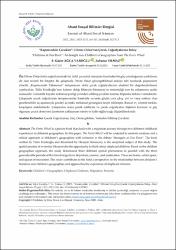| dc.contributor.author | Ağca Varoğlu, Fatma Güzin | |
| dc.contributor.author | Yılmaz, Sabanur | |
| dc.date.accessioned | 2024-04-04T15:31:20Z | |
| dc.date.available | 2024-04-04T15:31:20Z | |
| dc.date.issued | 2023 | en_US |
| dc.identifier.citation | Ağca Varoğlu, F. G., Yılmaz, S. (2023). “Kapımızdaki Çocuklar”: Dönme Dolap’tan Çocuk Coğrafyalarına Bakış. Abant
Sosyal Bilimler Dergisi, 23(3), 1513-1531. | en_US |
| dc.identifier.uri | https://hdl.handle.net/20.500.12846/1013 | |
| dc.description.abstract | Dönme Dolap farklı coğrafyalardaki iki farklı çocukluk deneyimi üzerinden bir göç yolculuğunun yankılarını
ele alan resimli bir kitaptır. Bu çalışmada Dönme Dolap göstergebilimsel analize tabi tutularak göçmenlere
yönelik „Kapımızdaki Yabancılar“ tartışmasına atıfla çocuk coğrafyalarının eleştirel bir değerlendirilmesi
yapılacaktır. Tülin Kozikoğlu’nun kaleme aldığı Hüseyin Sönmezay’ın resimlediği eser bu çalışmanın analiz
nesnesidir. Gündelik hayatın mekânsal pratiği yerinden edilmiş çocuklar üzerine düşünme imkânı vermektedir.
Çalışmada çocuk coğrafyaları tartışmasından hareketle zorunlu göçün yola çıkış, yol ve varış noktası olan
genellenebilir üç aşamasıyla paralel üç farklı mekânsal görüngüsü tespit edilmiştir. Bunlar ev, kentsel mekân,
karşılaşma mekânlarıdır. Çalışmanın alana çocuk edebiyatı ve çocuk coğrafyaları ilişkisini kurması ve göç
olgusuna çocuk deneyimi üzerinden yaklaşması sebebiyle katkı sağlayacağı düşünülmektedir. | en_US |
| dc.description.abstract | The Ferris Wheel is a picture book that deals with a migration journey through two different childhood
experiences in different geographies. In this paper, The Ferris Wheel will be subjected to semiotic analyses and a
critical approach of childrens’s geographies with reference to the debate "Strangers at Our Door". The book
written by Tülin Kozikoğlu and illustrated by Hüseyin Sönmezay is the analytical subject of this study. The
spatial practice of everyday life provides the opportunity to think about displaced children. Based on the children
geographies approach, the study determined three different spatial phenomena in parallel with the three
generalizable periods of the forced migration: departure, journey, and destination. These are home, urban space,
and spaces of encounter. The study contributes to the field a perspective on the relationship between children's
literature and children's geographies and approaches the experience of displaced children. | en_US |
| dc.language.iso | tur | en_US |
| dc.rights | info:eu-repo/semantics/openAccess | en_US |
| dc.subject | Çocuk coğrafyaları | en_US |
| dc.subject | Göç | en_US |
| dc.subject | Yerinden edilmiş çocuklar | en_US |
| dc.subject | Göstergebilim | en_US |
| dc.subject | Children’s geographies | en_US |
| dc.subject | Displaced children | en_US |
| dc.subject | Migration | en_US |
| dc.subject | Semiotic | en_US |
| dc.title | “Kapımızdaki Çocuklar”: Dönme dolap’tan çocuk coğrafyalarına bakış | en_US |
| dc.title.alternative | “Children at Our Door”: An insight into children’s geographies from the ferris wheel | en_US |
| dc.type | article | en_US |
| dc.relation.journal | Abant Sosyal Bilimler Dergisi | en_US |
| dc.identifier.volume | 23 | en_US |
| dc.identifier.issue | 3 | en_US |
| dc.relation.publicationcategory | Makale - Ulusal Hakemli Dergi - Kurum Öğretim Elemanı | en_US |
| dc.contributor.department | TAÜ, Kültür ve Sosyal Bilimler Fakültesi, Sosyoloji Bölümü | en_US |
| dc.identifier.startpage | 1513 | en_US |
| dc.identifier.endpage | 1531 | en_US |

















